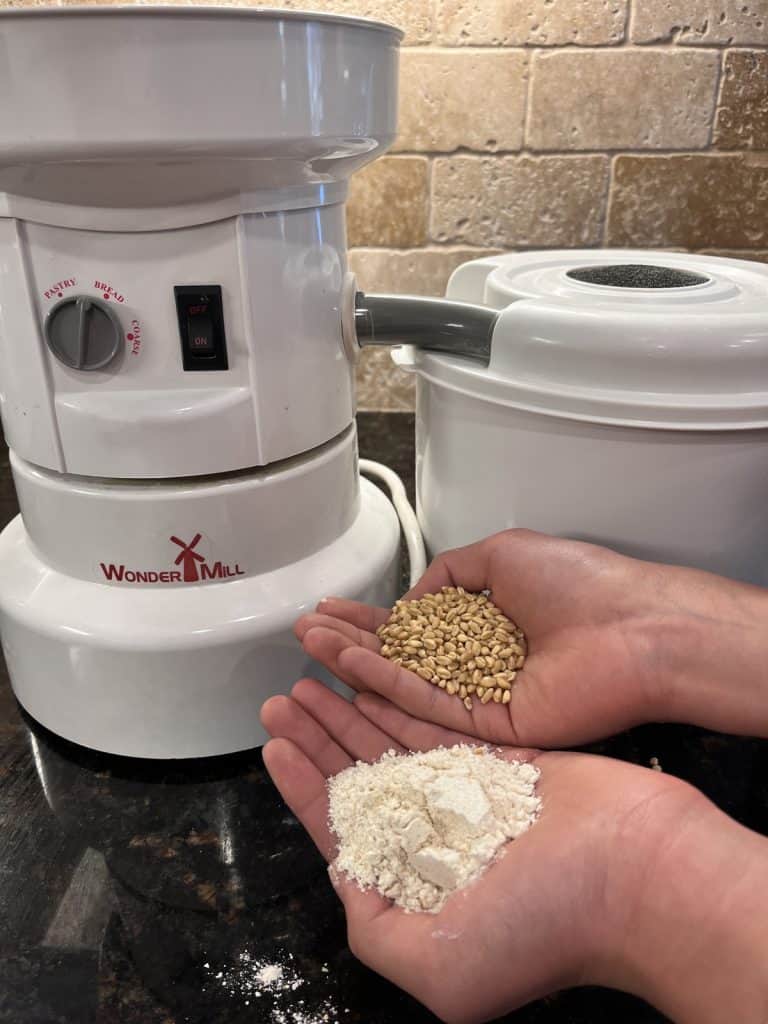
This site contains affiliate links to products. I may receive a commission for purchases made through these links at no extra cost to you.
Now that you know all about the benefits of whole grains and why you should avoid refined grains, you may want to know about how to incorporate more healthy grains into your life. One delicious way is to learn how to grind wheat into flour, then utilize for all your baking needs.
Why Should I Grind My Own Wheat?
I’ll never forget going over to a friend’s house almost 20 years ago and her showing me how she ground her wheat to make bread. It seemed so absolutely foreign to me that I needed hand-holding! As a consequence of that experience, it helped form me into a mama that wanted the very best for my kids and their growing bodies. The feeling of taking a whole product and transforming it into something I could bake with just gave me such a satisfied heart.
Aside from feeling like Martha Stewart, the health benefits are what has kept me grinding grain all these years later! The nutrients in freshly ground wheat cannot even compare to the bread at the store. Even buying whole wheat flour in a bag has lost all of its nutrients aside from a small amount of remaining fiber.
Nutrients in Freshly Ground Flour
Many people begin their bread making journey using whole wheat flour in a bag from the store. While this is a major step up from consuming store-bought bread, there is something missing. That something is all the nutrients found in the wheat kernel! As we talked about before, the germ and bran contain numerous vitamins and minerals that get lost in refining. You can see from the chart below that everything decreases dramatically once all that is left is the endosperm, or starch.

How to Store Freshly Ground Flour
The interesting thing to note is that fresh food is always best, and wheat is no exception. When wheat kernels are ground, all those wonderful nutrients go down by 45% at 24 hours after milling. After 48 hours, it’s up to 90% nutrients lost! This is bad news for that bag of ground wheat sitting on the grocery shelf for months. Since we are wanting the nutrients from the flour, fresh is best.
Some people actually store their grain mill on a kitchen counter. Since I love being in my kitchen, I have too many gadgets out already to do that! I grind wheat fresh for making my bread, which I do on a weekly basis. I also will grind up a larger portion of soft wheat (see below) and store in the freezer. I’ve heard mixed thoughts on the nutrient content when you store the flour, but we know freezing slows down nutrient loss. In my mind, it would preserve it much the same way nutrients in frozen fruits and vegetables are preserved. So best case, use it fresh; if you need to store it, stick a bag in the freezer and use within a month for best nutrient retention.
Soft Wheat vs. Hard Wheat
Hard wheat has a higher amount of protein and gluten. This makes it perfect for baked items requiring structure such as breads and pizza dough. Another way I like to phrase it is, use hard wheat any time you would use yeast for rising. Soft wheat, on the other hand, has less gluten so less structure with rising. It’s best used for muffins, pancakes, and waffles. I actually tried soft wheat one time for baking bread, and sure enough, it was a flop!
As I explained in my post on making easy biscuits from scratch, when something needs more “fluff,” I like to use half soft wheat and half all purpose. I understand that sounds like I’m contradicting myself on using refined flour! But trust me, put hockey pucks on the table and see if anyone eats them. 🙂 In instances when you’re making any type of “quick bread” (ones that rely on baking powder or baking soda and not yeast) that need to rise well, doing half and half is a good compromise. I use full soft wheat for things like cookies, pancakes, and waffles.
Other Types of Grain for Baked Goods
Many folks in the natural health space are opposed to using modern wheat because it has been hybridized. This means that two or more types of wheat have been used to fertilize one another to encourage desired traits. This happens all the time in nature, and for sure happens in all food groups in our food supply. Even in my own garden I grow hybrid tomatoes.
According to The Farmers Almanac: “Hybrids should not be confused with genetically modified organisms (GMOs), which are genetically altered in a lab. Unlike GMOs, hybrid fruits and vegetables are created by the mating of 2 varieties or cultivars within a single species, or between different species within the same genus. Although many hybrids you see are cross-pollinated artificially, this phenomenon happens quite frequently in nature. This is essentially how new species of plants arise over time. Thank the pollen and bees, and the wind and seeds.
In fact, many familiar fruits and vegetables that we commonly eat today are creations of hybridization and are nothing like their ancient, wild counterparts. Boysenberries (raspberries, loganberry, blackberries), grapefruit (pomelo and orange), the traditional yellow banana, and many apple varieties (honey crisp) are all a product of hybridization.”
I use hard white (this is a variety, NOT white bread!) and soft white berries because this is the most frugal choice. After doing my research, I don’t feel there is any less health benefit.
Other types to consider are Spelt, Emmer, and Einkorn. These are all considered ancient grains and are all still wheat. Many people are drawn to them because they have been in existence for thousands of years and have never been hybridized. There is for sure a price point difference, with Einkorn being almost double hard wheat.
How Much Flour is Yielded From Berries
Once cup of wheat berries (or spelt or Einkorn) yield about one and a half cup of flour. It’s beautiful to me that in God’s provision you get more than what you start with! I get seven cups of flour from about four cups of berries.
What Tools Do I Need for Grinding My Own Flour?
You will need a grain mill, sometimes called wheat grinder, for grinding any grains. I have used the Wonder Mill for 18 years and LOVE it! In all that time I’ve never had a single issue. It grinds not only every type of grain but also every type of dried bean (for instance, to make garbanzo flour) and whole kernel dried corn to make cornmeal! A mill is an investment, but more than likely one you’ll never have to make again. To purchase the Wonder Mill, go here.

Where to Buy Grains for Grinding Into Flour
There are several ways to purchase grain. I was very spoiled in our last home and had two Amish stores within an hour of me. There are also a couple of co-ops that you can find that deliver in bulk, and therefore, have much cheaper shipping. A wonderful resource is Pleasant Hill Grain. They carry most everything you would want for your kitchen, in addition to a wonderful selection of dried goods, including grains. The best thing is free shipping over $79! You can’t beat that because these pails are very heavy and one site I looked on charged as much for shipping as for the product!
- If you want to purchase hard wheat for bread making, go here.
- If you want to purchase soft wheat for quick breads, go here.
- If you want to try the ancient wheat called spelt, go here.
- If you want to try the oldest cultivated wheat, Einkorn, go here.
Whereas freshly milled flour has a short shelf-life, the whole grain can be kept for years. I prefer to store in large buckets, which is the form all the grains above are purchased in. This will keep it fresh and sealed so no pests can get to your grain.

